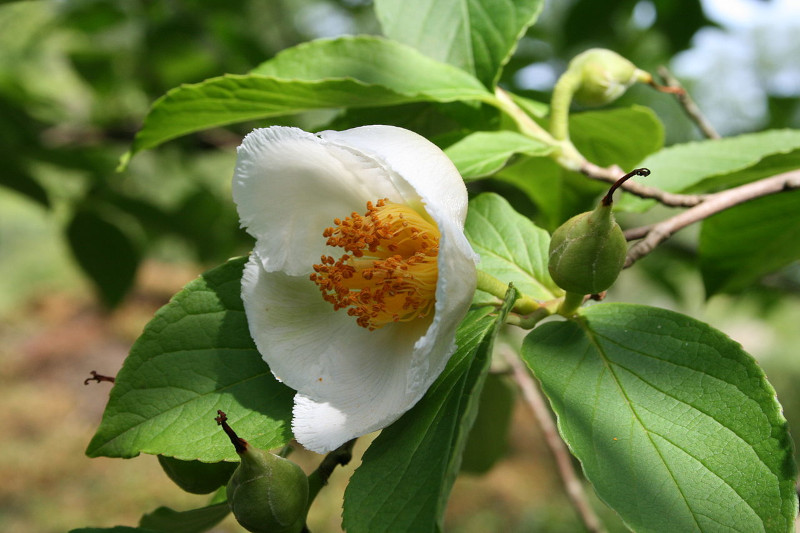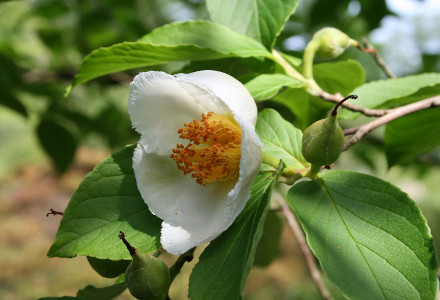
Photographer: Uleli
CC License: https://bit.ly/3e6cyTn
Stewartia Facts
- Most notably, the Stewartia serves as the collective common name for a genus of beautiful flowering plants. in point of fact, the various members of the group bear a close relationship to the equally lovely camellia. For the moment, scientists place approximately 20 recognized species within this marvelous grouping of flowering plants.
- In addition, the great beauty of the various plants placed in the scientific group has led to an extreme popularity with the public. As a result, several members of this genus have also become quite popular as ornamental plants. This popularity occurs because of the fact that the varieties in question actually possess orange bark, and bloom when most trees lie dormant.
- Sometimes referred to by the alternate spelling of Stuartia, the amazing plants also remain the source of some debate. That’s because many botanists dispute the placement of different species within the genus. By whatever name one calls it, all forms of the Stewartia remain stunning plants. Quite unfortunately, several members of this group now qualify as Endangered.
Related Articles
Wax Currant Nevin’s Barberry Bleeding Heart
Stewartia Physical Description
First of all, all known forms of the fascinating Stewartia understandably have many physical characteristics in common with each other. This mainly holds true due to the fact that every plant within the genus appears as either a tree or a shrub. Furthermore, the majority of these develop as deciduous. Nevertheless, a few of the different species developed as evergreen in nature.
Quite interestingly, those plants evolving in different parts of the world develop different characteristics. The species endemic to one region include both evergreen and deciduous varieties. Depending on the exact species, these attain heights ranging from 9.8-65.5 ft (3-20 m). But, those endemic to another region all develop as the large shrub variety. These attain a range of heights from 9.8-16.4 ft (3-5 m).
In addition, the bark of all varieties of Stewartia presents its own distinctive qualities. That’s because this has a highly distinctive appearance. In color, it typically presents as a yellow-brown to orange in color. Further, the flowers of most plants in this genus grow large and extremely conspicuous. These blooms may be as large as 4 in (10 cm) in diameter. Finally, in color these typically show white.
- Kingdom: Plantae
- Phylum: Tracheophytes
- Class: Angiosperm
- Order: Ericales
- Family: Theaceae
- Genus: Stewartia
Photographer: Uleli
CC License: https://bit.ly/3aHHg1j
Stewartia Distribution, Habitat, and Ecology
Perhaps most worth noting, the great majority of the breathtaking Stewartia varieties developed within the area now known as eastern Asia. More specifically, this area includes Japan, China, Korea, and Thailand, just to name a few of the countries in which it appears in this vast area of the world.
However, two of the species placed within the scientific grouping appear to be native to specific regions within North America. These species, themselves impressive, occur naturally in a wide range. That’s a zone extending from the states of Virginia and Kentucky to Florida and Louisiana, in the United States.
This impressive genus also has highly specific, and somewhat unusual, habitat requirements. That’s because it generally appears in regions composed of soil with a high acidity level. Furthermore, the plants also require prolific quantities of rainfall and does not tolerate drought conditions.
Species Sharing Its Range
Chinese Lantern Florida Panther American Crocodile
Check out our other articles on 4 Geological Wonders of Antarctica, Great Hammerhead Shark, Salar de Uyuni, Saint Francis’ Satyr Butterfly, Laotian Giant Flying Squirrel, Wood Frog

